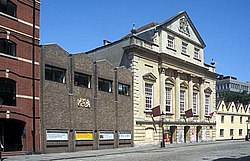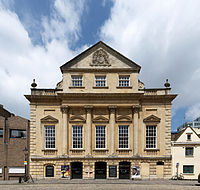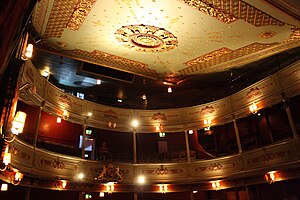Theatre Royal, Bristol
| Theatre Royal | |
|
Gloucestershire | |
|---|---|
 Coopers' Hall and the Theatre Royal | |
| Type: | Theatre |
| Location | |
| Grid reference: | Expression error: Unexpected < operator.&y=Expression error: Unexpected < operator.&z=120 ST588217272 |
| Location: | 51°27’7"N, 2°35’38"W |
| City: | Bristol |
| History | |
| Address: | King Street |
| Built 1766 | |
| By: | Thomas Paty & James Saunders |
| Theatre | |
| Information | |
| Owned by: | Bristol Old Vic and Theatre Royal Trust Limited |
| Website: | Bristol Old Vic |
The Theatre Royal in Bristol, now also known as 'Bristol Old Vic', is the oldest continually-operating theatre in the English-speaking world. It was built between 1764 and 1766 on King Street in Bristol,[1] on the north side of what was then the course of the River Avon (and thus on the Gloucestershire side of the city).
The Coopers' Hall, built 1743–44, was incorporated as the theatre's foyer during 1970–72. Together, they are designated a Grade I listed building by Historic England.[2] Daniel Day-Lewis called it "the most beautiful theatre in England."[1]
The theatre is now run by the Bristol Old Vic, a theatre company established in 1946 as an offshoot of the Old Vic in London, and now based at the Theatre Royal. The company is associated with the Bristol Old Vic Theatre School, which became a financially independent organisation in the 1990s. The company and the Theatre Royal Trust which owned the theatre merged in 2010,[3] to create the Bristol Old Vic and Theatre Royal Trust Limited, a registered charity.[4]
History
The theatre stands on King Street, a few yards from the Floating Harbour. From 1972 until 2016, the public entrance was through the Coopers' Hall, the earliest surviving building on the site.
Coopers' Hall

The Coopers' Hall was built in 1744 for the Coopers' Company, the guild of coopers in Bristol, by the architect William Halfpenny.[5] It has a "debased Palladian" façade with four Corinthian columns.
The hall though built for the Coopers' Company, only remained in the company's hands until 1785: thereafter it became a public assembly room, a wine warehouse, a Baptist chapel and eventually a fruit and vegetable warehouse.[6]
Theatre Royal
The theatre was built between 1764 and 1766.[2] The design of the auditorium has traditionally been taken to have been based, with some variations, on that of the Theatre Royal, Drury Lane in London.[7] Although a Bristol architect, Thomas Paty, supervised construction, the theatre was built to designs by James Saunders, David Garrick's carpenter at Drury Lane.[8] Saunders had provided drawings for the theatre in Richmond, Surrey, built in 1765. A long section (1790, at Harvard University Theatre Collection) and a survey plan (1842, at the Local Studies Library) of the Richmond theatre show close similarities with the Bristol theatre in the proportions and in the relationship between the actors on stage and the spectators surrounding them on three sides.
The site chosen was Rackhay Yard, a roughly rectangular empty site behind a row of mediæval houses and to one side of the Coopers' Hall. Two (and possibly three) new passageways built through the ground floor of the houses fronting King Street gave access to Rackhay Yard and the "New Theatre" inside it.[9]
The theatre opened on 30 May 1766 with a performance which including a prologue and epilogue given by David Garrick. As the proprietors were not able to obtain a Royal Licence, productions were announced as "a concert with a specimen of rhetorick" to evade the restrictions imposed on theatres by the Licensing Act 1737.[10] This ruse was soon abandoned, but a production in the neighbouring Coopers' Hall in 1773 did fall foul of this law.
Legal concerns were alleviated when the Royal Letters Patent were eventually granted in 1778, and the theatre became a patent theatre and took up the name "Theatre Royal".[10] At this time the theatre also started opening for the winter season, and a joint company was established to perform at[11] both the Bath Theatre Royal and in Bristol, featuring famed performers such as Sarah Siddons.[12]
In 1800 the auditorium was rebuilt with a new sloping ceiling and gallery. After the break with Bath in 1819 the theatre was managed by William M'Cready the Elder, with little success, but slowly rose again under his widow Sarah M'Cready in the 1850s.[7] Following her death in 1853 the M'Creadys' son-in-law James Chute took over, but he lost interest in the Theatre Royal, which fell into decline when he opened the Prince's Theatre, originally known as the New Theatre Royal, in 1867. A new, narrow entrance was constructed through an adjacent building in 1903.[7]
Formation of the Bristol Old Vic

Chute relinquished his lease on the Theatre Royal in 1861,[7] concentrating his business at the Prince's Theatre. Long after his time, the Prince's Theatre was destroyed by bombing during the Second World War.[13]
In 1942 the lease owners put the building up for sale.[14] News of the sale raised the threat that the building would be lost as a theatre, and a public appeal was mounted to preserve its use, and as a result a new Trust was established to buy the building. The Council for the Encouragement of Music and the Arts (CEMA) leased the building from the Trust[7] and in 1946 CEMA's successor, the Arts Council, arranged for a company from the London Old Vic to staff it, thus forming the Bristol Old Vic.
The Arts Council remained involved until 1963 when their role was taken over by the City Council. In the same year the London Old Vic was disbanded and the Bristol company became fully independent. The Bristol Old Vic also put plays on in the council-owned Little Theatre from then until 1980.
A new theatre complex, designed by Peter Moro, was completed in 1972.[7] The 1903 entrance building was demolished, as were a number of surrounding buildings and, more controversially, the stage area of the 1766 theatre. A new stage and fly tower were built along with technical facilities and offices. The 150-seat New Vic studio theatre (later known as the Studio) was built in place of the old entrance, and the Coopers' Hall provided the theatre with the grand façade and foyer area it had previously lacked.[6]
Throughout the 1970s and 80s Bristol Old Vic productions were well received both locally and on tour, but by the late 80s faced a lack of money. The following generation saw revivals and declines and finally a thorough-going refurbishment of the theatre from 2007.
Outside links
| ("Wikimedia Commons" has material about Theatre Royal, Bristol) |
- Bristol Old Vic
- National Monuments Record: No. 1008195 – The Theatre Royal
- University of Bristol:
- The Theatre Royal at Looking at Buildings
- Behind the scenes at Bristol Old Vic – video report from BBC Bristol
References
- ↑ 1.0 1.1 'Bristol Old Vic Theatre marks 250th anniversary': BBC 30 May 2016
- ↑ 2.0 2.1 National Heritage List 1209703: The Theatre Royal, Bristol
- ↑ 'Trust merger ‘will secure Vic's future’': The Post, Friday, October 01, 2010
- ↑ Bristol Old Vic and Theatre Royal Trust Limited - Registered Charity no. 228235 at the Charity Commission
- ↑ 'Redeveloping Bristol Old Vic': Bristol Old Vic
- ↑ 6.0 6.1 Manser, José (1 December 1972). "Theatrical renaissance in Bristol". Design (288). Archived from the original on 3 September 2014. https://web.archive.org/web/20140903080052/http://vads.ahds.ac.uk/diad/article.php?title=288&year=1972&article=d.288.30.
- ↑ 7.0 7.1 7.2 7.3 7.4 7.5 Mark Howell: 'Theatre Royal (Bristol)': The Theatres Trust
- ↑ Thorpe, Vanessa (9 September 2012). "Secrets of the rowdy past revealed as Bristol Old Vic reopens". Guardian. Archived from the original on 2 April 2015. https://web.archive.org/web/20150402222001/http://www.theguardian.com/stage/2012/sep/09/bristol-old-vic-reopens. Retrieved 13 March 2015.
- ↑ Howell, Mark (2014). Imaginative Genius: Spectators on Stage at Shakespeare's Playhouses & Bristol's Old Vic. Mark Howell. ISBN 9780992643713. https://books.google.com/books?id=avocBgAAQBAJ&pg=PT16&lpg=PT16&dq=Bristol+Old+Vic+Rackhay+Yard&source=bl&ots=BFS010F0WO&sig=alwGvdE09sbNXSomyqaBbP8RuJc&hl=en&sa=X&ei=sgUDVbm9OeO07gaqs4DYBA&ved=0CC0Q6AEwAg#v=onepage&q=Bristol%20Old%20Vic%20Rackhay%20Yard&f=false.
- ↑ 10.0 10.1 Moody, Jane. "Theatrical Geographies and the Birth of a National Stage". pp. 4–6. Archived from the original on 5 September 2006. https://web.archive.org/web/20060905155149/http://www.cla.purdue.edu/academic/engl/navsa/Conferences/2006/documents/MoodyCompanionfinals.doc. Retrieved 19 April 2009.
- ↑ Moody, Jane. "Theatrical Geographies and the Birth of a National Stage". p. 10. Archived from the original on 5 September 2006. https://web.archive.org/web/20060905155149/http://www.cla.purdue.edu/academic/engl/navsa/Conferences/2006/documents/MoodyCompanionfinals.doc. Retrieved 19 April 2009.
- ↑ 'A Passionate Sisterhood': New York Times
- ↑ "Peggy Ann Wood (1912–1998)". www.bristol.ac.uk. Archived from the original on 6 May 2016. https://web.archive.org/web/20160506232028/http://www.bristol.ac.uk/theatre-collection/explore/theatre/peggy-ann-wood-archive/. Retrieved 19 April 2009.
- ↑ "Bristol Old Vic, Theatre Collection, University of Bristol". www.bristol.ac.uk. Archived from the original on 6 May 2016. https://web.archive.org/web/20160506205551/http://www.bristol.ac.uk/theatre-collection/explore/theatre/bristol-old-vic-company-archive/. Retrieved 19 April 2009.
- Barker, Kathleen:
- 'The Theatre Royal Bristol 1766–1966: Two Centuries of Stage History' (The Society for Theatre Research, 1974) ISBN 0-85430-022-8
- 'The Theatre Royal Bristol: The First Seventy Years' (Bristol Branch of the Historical Association, 1961)
- Gomme, A., Jenner M. and Little, B.: 'Bristol: an Architectural History' (Lund Humphries, 1979)
- Howell, M. A.:
- 'Acting Space and Carpenters Tools': Around the Globe 47 (Dec. 2009), pp 34–35
- 'Planning Theatres Under the Stage Licensing Act, 1737' Theatre Notebook 43.3 (1989) with publisher's errata in Theatre Notebook 44.1 (1990)
- Ison, Walter: 'The Georgian Buildings of Bristol' (Kingsmead Press, 1952)
- Little, B. and Moro, P.: 'The Story of the Theatre Royal Bristol' (Trustees of the Theatre Royal, 1981)
- Williams, Audrey and Landstone, Charles: 'Bristol Old Vic—the First Ten Years' (J. Garnet Miller Limited, 1957)
